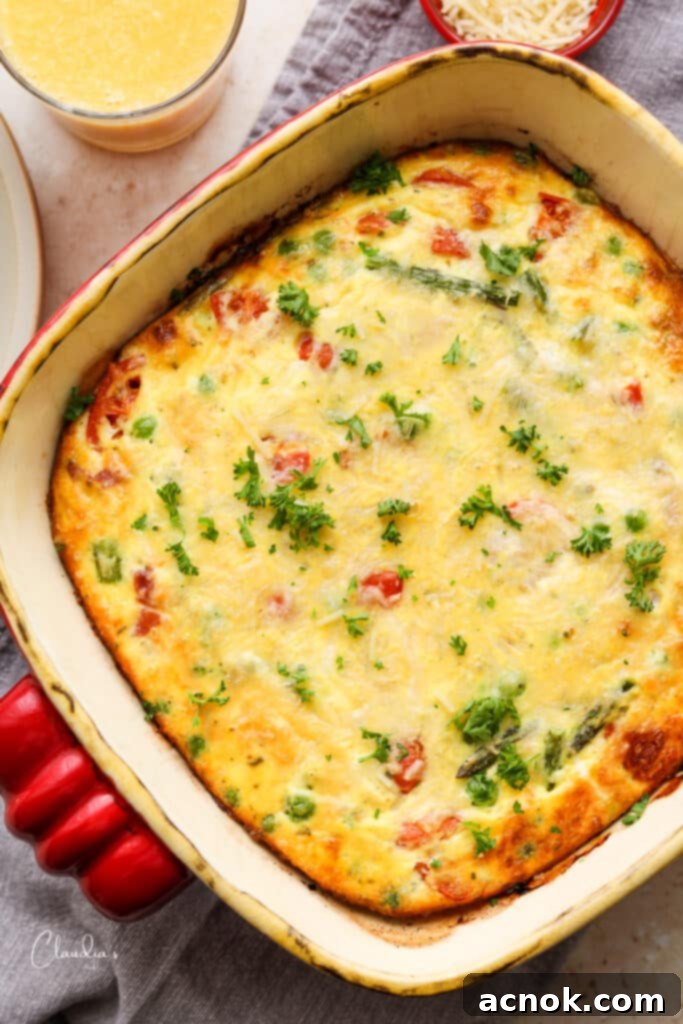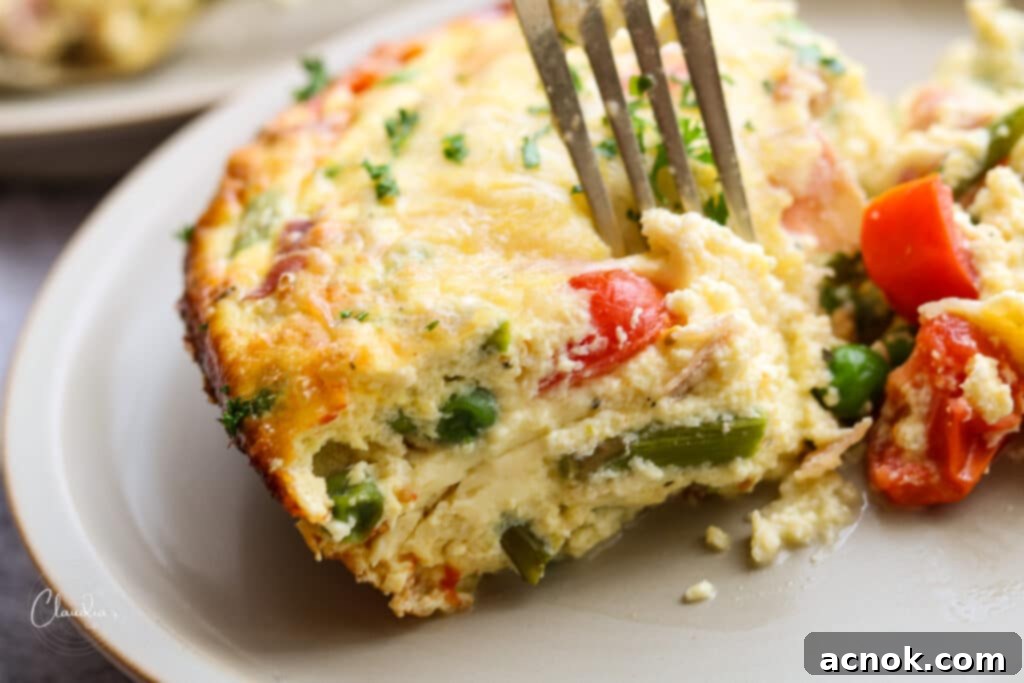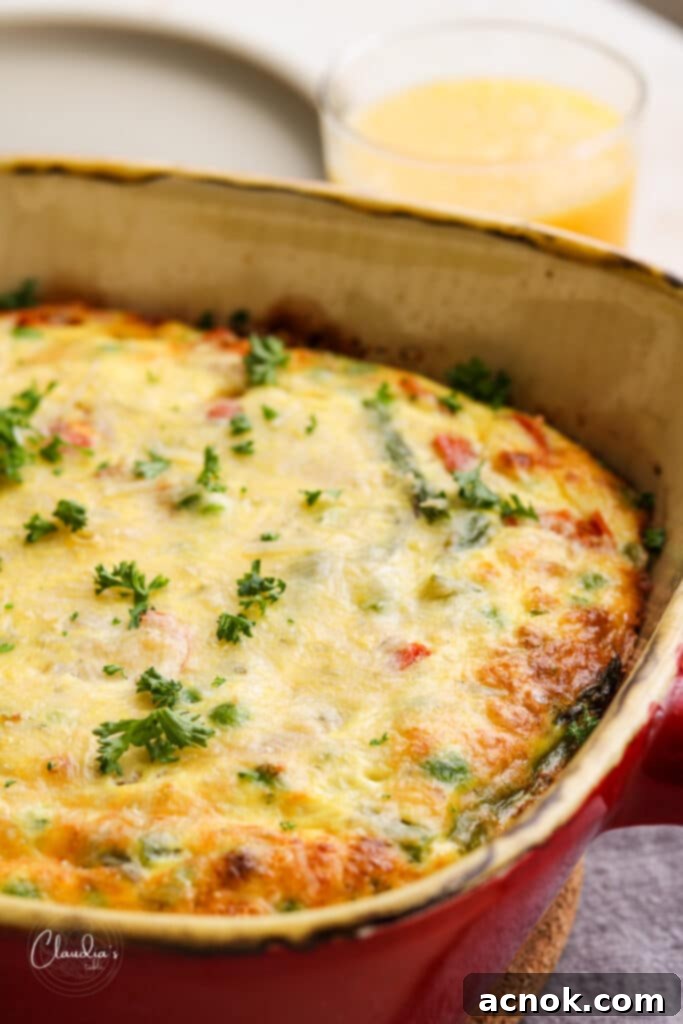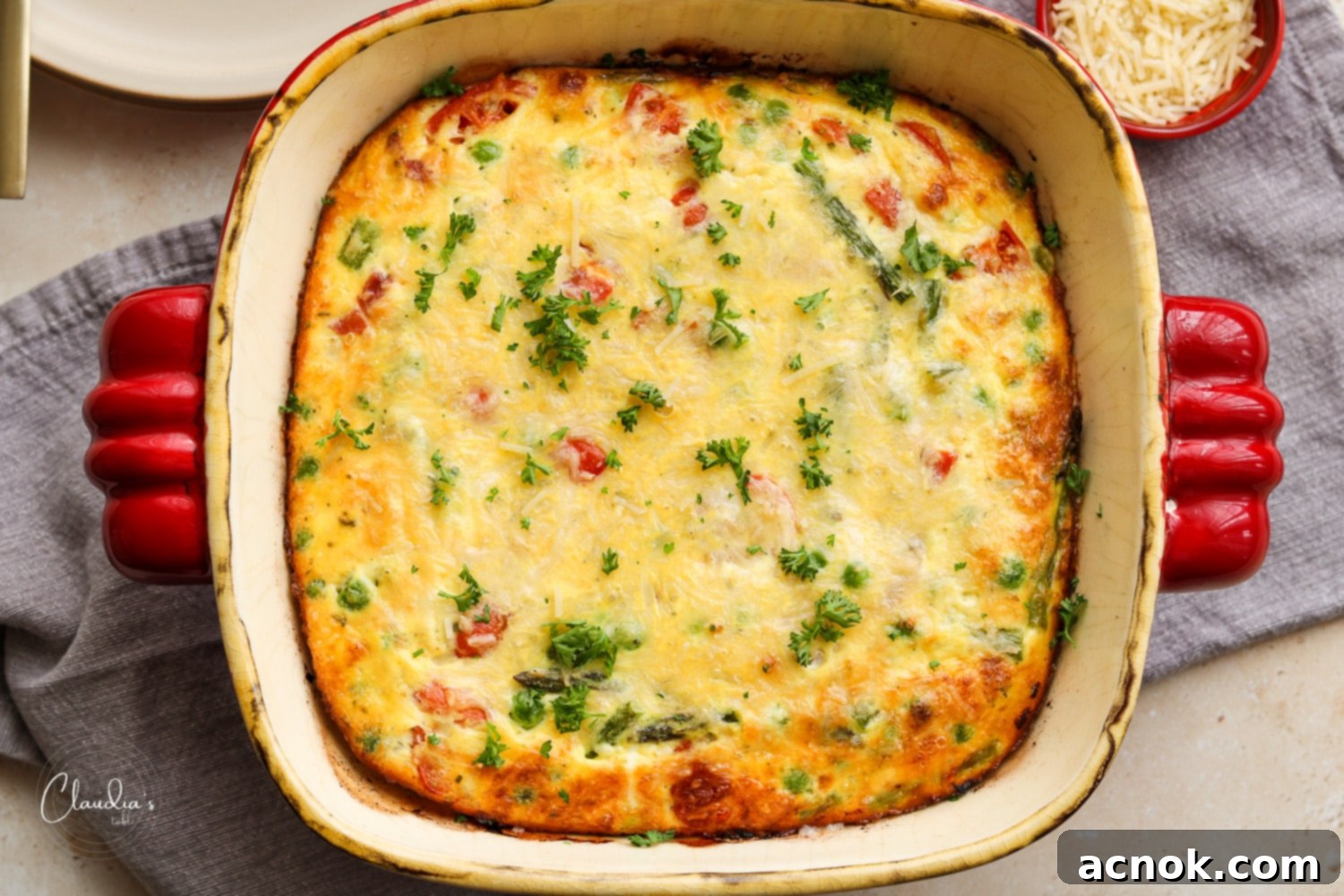Delicious Asparagus, Ricotta & Prosciutto Frittata: Your Perfect Easy Spring Brunch
As the days grow longer and nature awakens, asparagus season brings a delightful bounty to our tables. And what better way to celebrate the fresh flavors of spring than with a light, yet satisfying Asparagus Frittata with Ricotta and Prosciutto? This elegant dish beautifully showcases the season’s best – tender roasted asparagus, sweet peas, and juicy baby tomatoes – all harmoniously blended with an exquisite Italian cheese medley, savory bits of prosciutto, and the creamy richness of ricotta. It’s not just a meal; it’s a visual treat, making it absolutely worthy of your next special occasion or a leisurely weekend brunch with loved ones.

Table of contents
- Why You’ll Love This Easy Frittata Recipe
- What’s the Difference Between a Frittata, Omelette, and a Casserole?
- Preparing Your Ingredients for Success
- How to Make Asparagus Frittata with Ricotta and Prosciutto
- Roasting the Asparagus to Perfection
- Assembling and Baking Your Fluffy Frittata
- Delicious Variations to Explore
- Easy Ingredient Substitutions
- How to Serve Your Frittata
- How to Store Leftover Frittata
- Frequently Asked Questions
Why You’ll Love This Easy Frittata Recipe
Frittatas are truly a breakfast hero – incredibly simple to make, whether you’re cooking for one or serving a crowd of twelve. Their versatility is unmatched; you can easily swap out vegetables or proteins based on what you have on hand, and the process is almost foolproof. Need to feed more people? This recipe scales effortlessly, allowing you to double or triple the yield from the recipe card without a hitch. As a huge fan of baked egg dishes, I can attest that this frittata stands out. If you love baking your eggs, you should also explore my Weekend Breakfast Casserole, a delightful “kitchen sink” type recipe, or my absolute favorites like Baked Mexican Chorizo and Eggs, and the convenient Chorizo Egg Bites for busy mornings.
What sets this specific Asparagus Frittata apart is its incredibly light and airy texture, largely thanks to the addition of creamy ricotta cheese. Every single bite is a symphony of flavors and textures: the delicate chew of roasted asparagus, the pop of sweet tomatoes, the satisfying crunch of fresh peas, salty notes from the prosciutto, and a luxurious melt of Italian blend cheese, all perfectly rounded out by the fluffy egg base. It’s a comforting yet sophisticated dish that will quickly become a favorite.
What’s the Difference Between a Frittata, Omelette, and a Casserole?
Understanding the nuances between these popular egg dishes can help you appreciate their unique qualities. The word “frittata” itself is derived from the Italian verb friggere, meaning “to fry.” A traditional frittata typically starts on the stovetop in an oven-safe pan, where eggs are whisked thoroughly to incorporate air, creating a light and fluffy texture. It’s then filled with a variety of ingredients like vegetables, protein, and cheese, before being finished in the oven to set. Baking it from start to finish in a casserole dish, as we do here, is a perfect, hands-off alternative that yields consistently delicious results.
An omelette, on the other hand, involves eggs that are typically blended quickly and poured into a hot pan. The fillings are often added to one side of the eggs and then folded over, cooked just until the eggs are set but still soft and moist, with cheese often melted inside. Omelettes are usually single-serving and cooked relatively quickly on the stovetop.
A breakfast casserole, while also egg-based, often includes a more substantial starch component like potatoes, along with various vegetables, proteins, and cheeses. Casseroles are usually baked entirely in the oven, often prepared in advance, and designed to feed a larger group, making them heartier and more robust than a frittata. While all three are fantastic breakfast or brunch options, this Asparagus Frittata with Ricotta and Prosciutto offers a unique blend of elegance, simplicity, and delightful texture that makes it just a little extra special.
Preparing Your Ingredients for Success
To ensure your frittata comes out perfectly, preparing your ingredients beforehand is key. Here’s what you’ll need, along with a few tips for each:
For the Roasted Asparagus:
- 1/2 lb asparagus: Choose vibrant, firm spears. Trimming the tough woody ends ensures every bite is tender. Washing and thoroughly drying prevents steaming during roasting, allowing for better caramelization.
- 1 tbsp olive oil: A good quality olive oil will enhance the asparagus’s natural flavors and help it roast evenly.
- Pinch Kosher salt: Kosher salt provides a clean, balanced salinity, bringing out the sweetness of the asparagus.
For the Frittata Mixture:
- 8 large eggs: The foundation of our frittata. Fresh, good-quality eggs will yield the best flavor and texture.
- 1/4 cup whole milk: Adds richness and helps create a tender, custardy texture.
- 1/2 tsp Italian dried herbs: A classic blend that infuses a warm, aromatic Italian essence into the frittata.
- 1/4 tsp sweet paprika: Offers a subtle sweetness and a beautiful, inviting color.
- 1/4 tsp onion powder: Provides a concentrated onion flavor without the moisture or texture of fresh onion.
- 1/8-1/4 tsp Kosher salt (optional): Remember that prosciutto and roasted asparagus are already seasoned, so adjust to your taste.
- 1 cup ricotta cheese: This is the secret to the frittata’s light, fluffy, and moist texture. Use whole milk ricotta for the best results.
- 1/2 cup Italian blend cheese, shredded: A mix of cheeses like mozzarella, provolone, and parmesan adds depth and meltiness.
- 2 oz Prosciutto, chopped: Salty, thinly sliced Italian cured ham that brings a wonderful savory depth to the dish.
- 1 cup cherry tomatoes, halved: Sweet and bursty, they add a pop of color and acidity. Quarter larger ones to ensure even distribution.
- 1 cup frozen peas (cooked and drained very well): Their bright sweetness and soft texture are perfect for spring. Crucially, cook them first and pat them dry to prevent excess moisture in the frittata.
- 1 cup roasted asparagus: The star of the show, pre-roasted to achieve a tender-crisp texture and concentrated flavor.
- 1/4 cup grated Parmesan cheese: For topping, adding a nutty, salty crust during baking.
- Non-stick spray: Essential for easy release and serving.
How to Make Asparagus Frittata with Ricotta and Prosciutto
Crafting this delightful frittata is a straightforward process, divided into two simple stages: roasting the asparagus and then assembling and baking the frittata itself.
Roasting the Asparagus to Perfection
Preheat your oven to a robust 400°F (200°C). Roasting the asparagus beforehand is crucial for developing its sweet, earthy flavor and achieving a perfectly tender-crisp texture, which is far superior to simply steaming it in the frittata.
- Start by trimming the tough, woody ends from your asparagus spears. A good tip is to hold an individual spear at both ends and bend it; it will naturally snap where the tender part begins. Wash the asparagus thoroughly under cool water and pat them completely dry with a clean kitchen towel. Any excess moisture will steam the asparagus instead of roasting it.
- Arrange the dried asparagus on a parchment paper-lined (optional, but recommended for easy cleanup) baking sheet. Drizzle with one tablespoon of olive oil and sprinkle with a pinch of Kosher salt. Toss gently to ensure each spear is evenly coated, then spread them out in a single layer, ensuring they don’t overlap too much. This allows for even roasting.
- Roast for 20 minutes, or until the asparagus is tender and slightly caramelized. Keep an eye on them; if your asparagus spears are particularly thin, they might be done in as little as 10-15 minutes. You’re looking for a vibrant green color and a tender bite.
- Once roasted, remove the asparagus from the oven and transfer them from the hot baking sheet to a cutting board or plate to cool slightly. Once cooled enough to handle, chop them into roughly 2-inch pieces. This should yield approximately 1 cup, perfect for our frittata. Leave your oven set to 400°F (200°C) – it’s ready for the frittata!
Assembling and Baking Your Fluffy Frittata
Now that your asparagus is prepped, it’s time to bring all the delicious elements together for the main event.
- First, prepare your peas. If using frozen, cook 1 cup according to package directions. Once cooked, drain them very well and then gently pat them dry with a paper towel. Removing excess moisture is important to prevent a watery frittata base.
- Generously spray a 3-quart casserole dish with nonstick spray. Make sure to coat the bottom and sides thoroughly. This step is crucial for easily serving your beautiful frittata without it sticking.
- In a medium-sized mixing bowl, whisk together the 8 large eggs with the whole milk, Italian dried herbs, onion powder, and sweet paprika. Whisk vigorously for about 1-2 minutes until the mixture is light, frothy, and well combined. This incorporates air, which contributes to the frittata’s fluffy texture. Regarding salt, remember the roasted asparagus is salted and prosciutto is naturally salty, so I recommend starting with 1/8 tsp of Kosher salt, tasting, and adding up to 1/4 tsp if desired.
- To the whisked egg mixture, gently fold in the shredded Italian blend cheese, halved cherry tomatoes, prepared peas, chopped prosciutto, roasted asparagus pieces, and the creamy ricotta cheese. Stir gently until all ingredients are just blended. Overmixing can toughen the eggs.
- Pour the frittata mixture into your prepared casserole dish. Evenly sprinkle the grated Parmesan cheese over the top. This will create a lovely golden crust.
- Place the casserole dish into the preheated 400°F (200°C) oven and bake for 40 minutes. The frittata is done when the center is set (a slight jiggle is okay, but it shouldn’t be liquidy), and the edges are lightly golden brown and puffed.
- Remove from the oven, let it cool for a few minutes to set further, then cut into quarters for serving. Garnish with a sprinkle of fresh, finely chopped parsley for an extra touch of color and freshness (optional). Serve warm with your favorite breakfast side dishes.

Delicious Variations to Explore
The beauty of a frittata lies in its adaptability. While this Asparagus, Ricotta, and Prosciutto Frittata is a masterpiece on its own, don’t hesitate to experiment with these delightful variations:
- Hearty Italian Sausage Frittata: For a more robust meal, swap out the asparagus and tomatoes for sautéed bell peppers and onions. Replace the prosciutto with crumbled, cooked Italian sausage (sweet or spicy, depending on your preference). This creates a warm and comforting frittata perfect for cooler mornings.
- Spinach & Mushroom Medley: Sauté a generous amount of fresh spinach and sliced mushrooms until their moisture has evaporated. Add these to the egg mixture instead of asparagus and peas. A sprinkle of feta cheese alongside the Italian blend cheese would complement this variation beautifully.
- Smoked Salmon & Dill: For an elegant twist, omit the prosciutto and add flakes of smoked salmon to the frittata mixture. Finish with a generous amount of fresh dill and perhaps a dollop of crème fraîche when serving. This makes for a luxurious brunch.
- Spicy Southwest Frittata: Incorporate diced jalapeños, black beans, and corn. Use a Monterey Jack or cheddar cheese blend, and serve with a dollop of salsa and avocado.
- Roasted Vegetable Delight: Roast a medley of your favorite seasonal vegetables like zucchini, yellow squash, bell peppers, and red onion before adding them to the frittata base.
Easy Ingredient Substitutions
This frittata recipe is wonderfully forgiving when it comes to substitutions, allowing you to tailor it to your dietary needs or whatever ingredients you have on hand. The key is to remember how certain ingredients, especially vegetables, might affect the moisture content.
- Vegetables: All of the vegetables can be easily swapped out for your favorites. If you’re using vegetables with high moisture content, such as zucchini, mushrooms, spinach, or other squashes, it’s crucial to cook them first to remove excess liquid. Roasting or sautéing them thoroughly before adding them to the egg mixture will prevent your frittata from becoming watery. For example, if using fresh spinach, sauté it until wilted and squeeze out all excess water. If using regular-sized tomatoes instead of cherry tomatoes, be sure to remove the seeds and extra liquid before dicing.
- Cheeses: The shredded Italian blend cheese can be readily swapped for other hard or semi-hard cheeses you prefer. Excellent choices include sharp cheddar, Monterey Jack, Gruyère, or even a provolone. Similarly, the grated Parmesan cheese for topping can be replaced with any of the hard cheeses mentioned, or a Pecorino Romano for a sharper flavor.
- Prosciutto Alternatives: If prosciutto isn’t available or you prefer a different flavor, there are several delicious substitutes. Black Forest ham, thinly sliced from the deli counter and chopped, works exceptionally well, offering a similar savory and slightly smoky note. Any other good quality smoked ham, pancetta (crisped first), or even cooked, crumbled bacon would make excellent additions. For a vegetarian option, simply omit the prosciutto and perhaps add a pinch more smoked paprika or a teaspoon of liquid smoke to the egg mixture for a hint of savory depth.
- Milk Alternatives: For a dairy-free version, you can substitute the whole milk with an unsweetened plain plant-based milk (almond, soy, or oat work well). The ricotta can be replaced with a dairy-free ricotta alternative or even blended silken tofu for a similar creamy texture.
- Herbs: Feel free to experiment with different dried or fresh herbs. A touch of fresh basil, oregano, or chives would be lovely additions.
How to Serve Your Frittata
This Asparagus Frittata with Ricotta and Prosciutto is a versatile dish that shines in many settings. For a simple yet satisfying everyday breakfast, I love to enjoy a generous slice alongside a fresh fruit salad and a piece of toasted sourdough bread. The slight tang of the sourdough perfectly complements the rich flavors of the frittata.
However, this frittata truly excels when served as the centerpiece of a elegant brunch. If you’re hosting, consider presenting the frittata buffet-style, allowing guests to serve themselves. Here are some ideas to create a memorable brunch spread:
- Fruit Platter: A vibrant array of seasonal fruits like berries, melon slices, and citrus segments adds freshness and color.
- Assorted Pastries: Offer a selection of croissants, muffins, or scones to add a sweet element.
- Greens: A simple mixed green salad with a light vinaigrette can cut through the richness of the eggs.
- Beverages: Elevate the occasion with a pitcher of sparkling mimosas, freshly squeezed orange juice, and a pot of gourmet coffee.
- Hot Sauce & Salsas: For those who enjoy a little kick, a variety of hot sauces or a fresh pico de gallo can be a welcome addition.
Its robust flavor profile and attractive presentation make it a fantastic option not just for breakfast or brunch, but also for a light lunch or even a casual weeknight dinner.

How to Store Leftover Frittata
Leftover frittata is just as delicious as when it’s freshly baked, making it an excellent candidate for meal prep! To store, allow the frittata to cool completely to room temperature. Then, transfer any remaining slices to an airtight container. For optimal freshness and safety, it’s best to consume leftover frittata within one day when stored in the refrigerator. However, it can often keep well for up to 2-3 days.
When it comes to reheating, you have a couple of convenient options:
- Microwave: For a quick reheat, place a slice on a microwave-safe plate and heat for 30-60 seconds, depending on your microwave’s wattage and the thickness of the slice. Heat until just warmed through to avoid overcooking the eggs.
- Oven: For a crisper result, especially if reheating multiple slices, preheat your oven to 400°F (200°C). Place the frittata slices in an oven-safe dish, covered loosely with aluminum foil to prevent drying out. Heat for about 10-15 minutes, or until the frittata is heated all the way through, ensuring there are no cold or lukewarm spots. This method helps maintain a better texture than the microwave.
Whether you’re enjoying it for breakfast, lunch, or a quick snack, proper storage and reheating ensure that every bite of your Asparagus Frittata with Ricotta and Prosciutto remains delightful.
Frequently Asked Questions
Absolutely! This frittata is a perfect recipe for meal prep. For individual portions, I highly recommend baking the mixture in a muffin tin or silicone molds. The baking time will be shortened to about 25-30 minutes. Once cooled, these mini frittatas can be stored in the refrigerator for 2-3 days or frozen for up to a month. To reheat from frozen, microwave for about 1-2 minutes, making sure they are heated thoroughly, or warm in a moderate oven.
While you can add frozen peas directly, be aware that they will release a bit of liquid as they cook within the frittata. This might result in a slightly wetter frittata base, with some liquid pooling at the bottom of the dish when you cut into it. If you don’t mind this (many people don’t!), then it’s a convenient shortcut that saves you an extra step.
Yes, this frittata is a fantastic make-ahead option! You can combine all the ingredients in your casserole dish, cover it tightly with plastic wrap, and refrigerate it overnight. In the morning, simply remove it from the fridge while the oven preheats, then bake as directed. Just ensure your casserole dish is safe to go from cold to a hot oven without issue (avoid extreme temperature changes with glass dishes).
No, a frittata and a quiche are distinct, though both are egg-based dishes. The primary difference is the crust: a frittata does not have a pastry crust, while a quiche always features a baked pie shell. Quiches also often contain a higher proportion of cream or milk, giving them a richer, more custard-like filling. If you’re looking for quiche recipes, I have a delicious Deep Dish Broccoli and Bacon Quiche, as well as a decadent Lobster and Asparagus Quiche.
Yes, you can substitute regular table salt for Kosher salt. However, since table salt is finer and denser, it’s typically saltier by volume. I recommend cutting the amount of salt in the full recipe by half when using regular table salt, and then adjusting to taste if needed.
Absolutely! Black Forest ham, thinly sliced and chopped from the deli counter, works wonderfully as a substitute for prosciutto, offering a similar salty and savory flavor profile. Any good quality smoked ham would also be a great choice. For a plant-based option, consider sun-dried tomatoes (packed in oil, drained and chopped) for a burst of umami.
A 3-quart baking dish, approximately 9×13 inches or a similar size, works perfectly for this recipe. You can use ceramic, glass, or metal. Just ensure it’s oven-safe and ideally, light-colored to prevent over-browning the edges too quickly. Always make sure to grease it very well!
If you tried this delightful Asparagus Frittata with Ricotta and Prosciutto recipe, please help other readers by commenting below and sharing some stars! We 🫶🏼 appreciate your feedback and love hearing how our recipes turn out for you!
All content and photographs ©Claudia’s Table and claudiastable.com

Asparagus Frittata with Ricotta and Prosciutto
Ana | Claudia’s Table
March 27, 2023
Pin Recipe
Equipment
-
1 3 qt casserole dish
-
1 rimmed baking sheet
-
parchment paper or non stick silicone baking mat optional
Ingredients
Roasted Asparagus
- 1/2 lb asparagus trimmed, washed and dried
- 1 tbsp olive oil
- pinch salt Kosher
Frittata
- 8 large eggs
- 1/4 cup milk whole
- 1/2 tsp Italian dried herbs
- 1/4 tsp paprika sweet
- 1/4 tsp onion powder
- 1/8-1/4 tsp salt Kosher
- 1 cup ricotta cheese
- 1/2 cup Italian blend cheese shredded
- 2 oz prosciutto chopped
- 1 cup cherry tomatoes halved
- 1 cup peas frozen. Once cooked, drain well and pat dry with a paper towel to remove excess moisture.
- 1 cup asparagus roasted (yield from above)
- 1/4 cup parmesan cheese grated
- non stick spray
- 1 tbsp parsley fresh, finely chopped for garnish (optional)
Instructions
Roasting asparagus
-
Preheat oven to 400°F (200°C). Trim the tough asparagus bottom ends. Wash and dry thoroughly and place on a parchment paper lined (optional to use parchment) baking sheet.
-
Add tablespoon of olive oil and pinch of kosher salt and toss well to evenly coat each asparagus spear. Ensure that the spears are evenly spaced and roast for 20 minutes or until tender. NOTE: If the asparagus you are roasting is very thin, roast for 10 minutes.
-
Remove from the oven and baking sheet and allow to cool. Once cooled, chop into 2 inch pieces to yield about 1 cup.
-
Leave oven set to 400ºF (200°C) for the frittata.
Frittata
-
To prepare peas, cook 1 cup to package directions. Once cooked, drain well and pat dry with a paper towel to remove excess moisture.
-
Spray a 3qt casserole dish with nonstick spray. Spray well so the frittata can be cut and easily served.
-
In a medium bowl, whisk eggs together with dried Italian herbs, onion powder, paprika and milk.
-
Add Italian shredded cheese, tomatoes, peas, prosciutto, asparagus spears and ricotta. Stir until blended.
-
Pour into the prepared casserole dish. Top with grated parmesan cheese and place in preheated oven and bake 40 minutes. The frittata will be done when the center is set and edges are lightly golden.
-
Remove from the oven, garnish with finely chopped parsley (optional), cut into quarters and serve with your favorite breakfast side dish.
Notes
Nutrition
Nutritional information is calculated online and should be used as a guide.
All content and photographs ©Claudia’s Table and claudiastable.com
Check out our New & Delicious posts below
- Pasta with Grilled Vegetables, Feta, and Lemon
- Grilled Asian Marinated Flank Steak
- Classic Homemade Chunky Blue Cheese Dressing
- 3-Ingredient Crispy Oven-Roasted Potatoes
- Grilled Peach Avocado Chicken Salad
